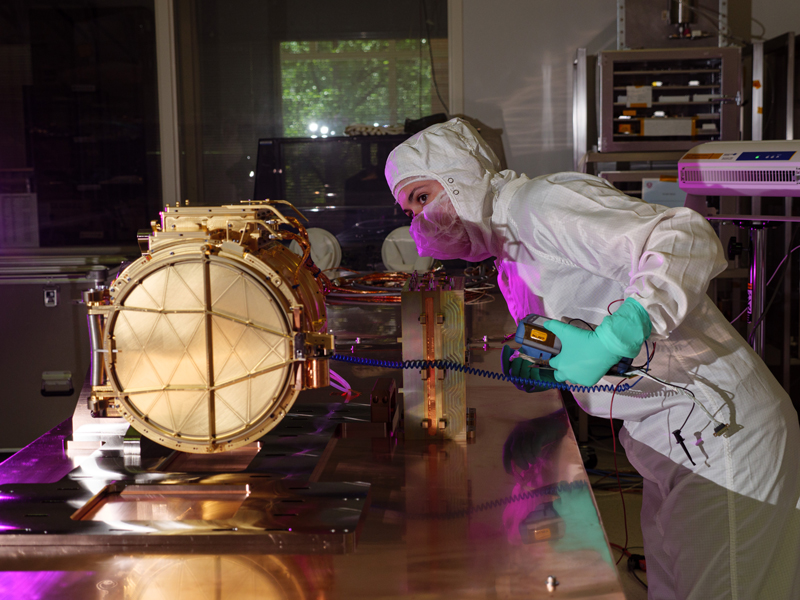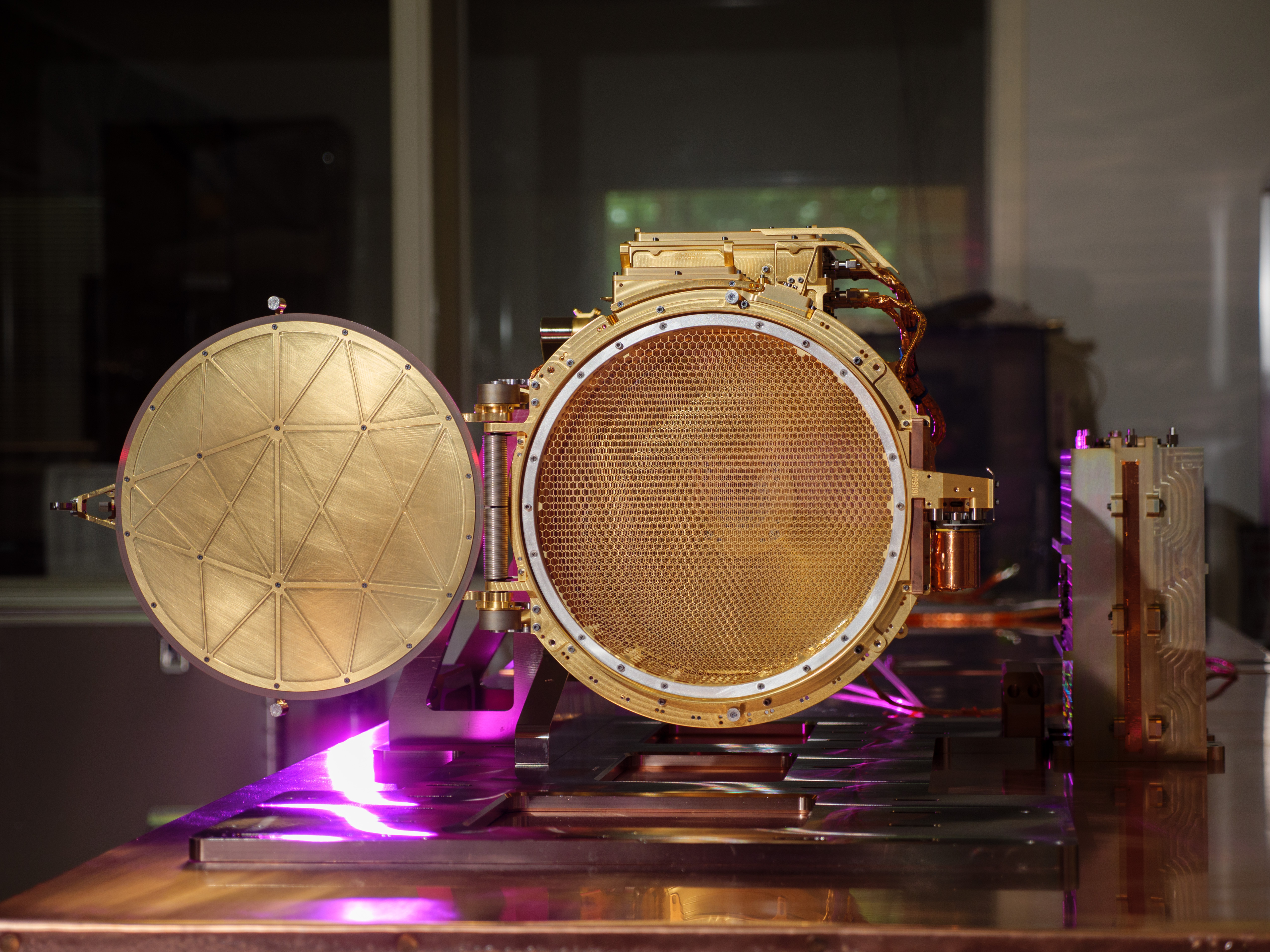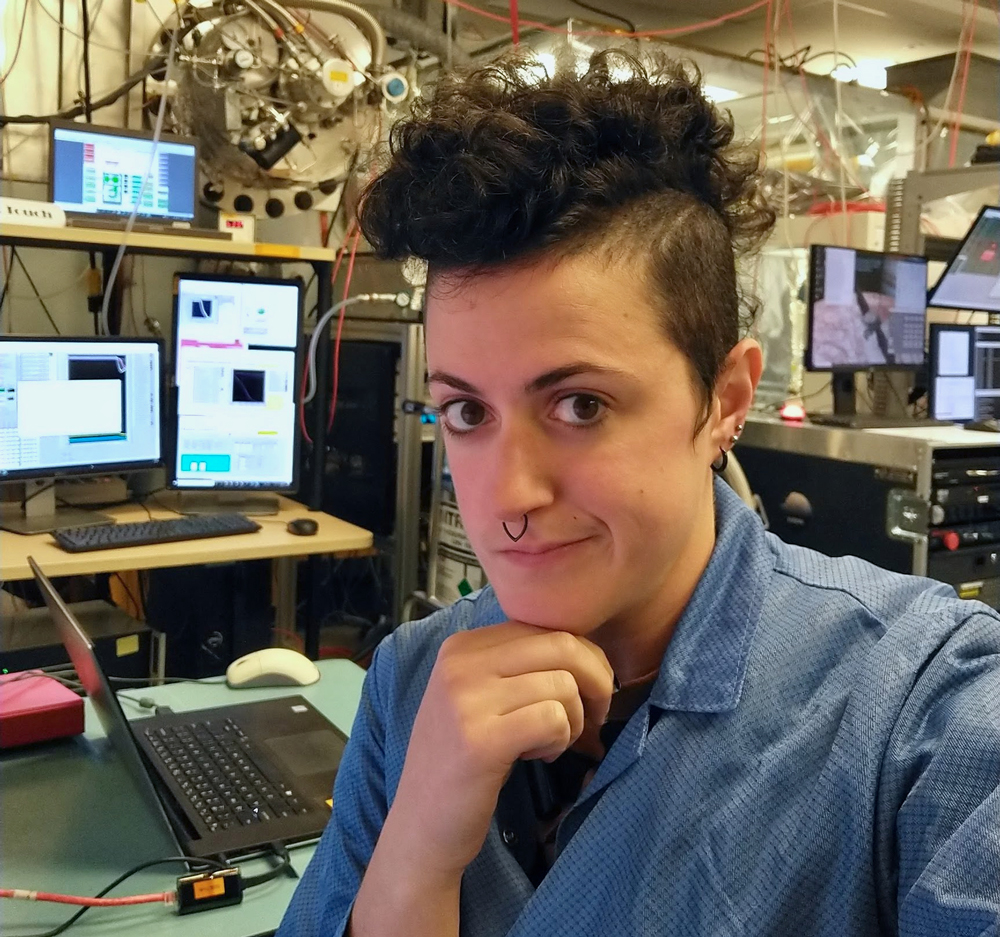
To assess whether Europa has the ingredients necessary for supporting life, Europa Clipper’s instruments will map the surface composition of Jupiter’s icy moon. But the spacecraft will not only look at Europa’s chemistry from afar. It also will collect and analyze samples of Europa’s surface, doing so without ever landing on the moon.
Micro-meteoroids rain upon Europa’s icy landscape, ejecting fragments of the moon’s surface into space. At any given time, about half a ton (500 kilograms) of surface material is floating around the moon as microscopic ejecta. When Europa Clipper sails past Europa, the spacecraft’s SUrface Dust Analyzer, or SUDA, works like a whale shark with an open mouth, collecting and digesting ejecta dust to identify its chemical composition and origin point from the surface.
Electrical engineer Elz DeVito is on the team that designed, built, and tested SUDA at the University of Colorado Boulder's Laboratory for Atmospheric and Space Physics (LASP). “Integration and testing is one of my favorite steps for an instrument,” DeVito said. “It’s exciting seeing how all the parts interact.”

The dust analyzer has two main components: an electronics box containing the computer and power system housed in Europa Clipper’s electronics vault, and a sensor head mounted on the outside of the spacecraft. Cylindrical and nearly 10 inches (24 centimeters) in diameter, the sensor head reassembles a big bucket about the size of a marching band drum. DeVito is responsible for assembling and testing one of the electronics boards mounted to the outside of that bucket. “As a dust particle interacts with grids and plates inside the sensor head, a charge is formed, and the charge is amplified by my board and sent to the processor,” they said.
To identify what the dust around Europa is made of, SUDA takes advantage of Europa Clipper’s speed. The spacecraft will be traveling several thousand miles (or kilometers) per hour, relative to the dust particles. Inside SUDA’s sensor head, incoming dust slams into an iridium-plated titanium target plate, instantly vaporizing dust into individual molecules. The impact also ionizes the molecules, which SUDA’s electrical fields then funnel to a detector that reveals the mass of each. SUDA can differentiate amino acids, sulfites, abiotic and biotic molecules, and more.
SUDA also records each dust particle’s speed and trajectory, allowing scientists to trace a parabolic arc from Europa Clipper’s location at the moment of detection to the region on Europa’s surface that the dust was ejected from. By analyzing hundreds (and sometimes thousands) of dust particles during each Europa flyby and tracing them back to regions on the moon, SUDA will allow scientists to identify the chemical composition of individual geologic features on Europa. Data from SUDA will be combined with that from other instruments to produce a more robust understanding of Europa’s surface chemistry than a single instrument could achieve.
To ensure SUDA is ready for that important work, DeVito and their colleagues spent much of this summer testing and calibrating the instrument. To simulate flight conditions, they put SUDA in a thermal vacuum chamber at LASP and successfully operated the instrument using the software it will use during the mission, and at higher and lower temperatures than it will experience on the mission. They then hurled dust particles at SUDA using a 3-megavolt dust accelerator to verify performance of the dust analyzer’s science channels. They also performed vibration, electromagnetic interference, and compatibility testing.

Throughout assembly and testing, DeVito and team have had one challenge above all: Keep it clean. “Anything that lands on our instrument before launch could contaminate our data when we get there,” DeVito said. “We always handle flight hardware with a lot of care, but for SUDA we’ve had to increase the rigor.”
SUDA isn’t DeVito’s first challenge. They grew up watching sci-fi and were mesmerized by outer space, but the path to space exploration is not always a straight line. “In high school I took an astronomy class, and I had a relative who worked in aerospace, so I thought, ‘I’m going to be an aerospace engineer,’ but I got to college and it wasn’t quite what I thought it was.”
Engineering in general still felt right though – it challenged DeVito’s mind – so they changed majors to electrical engineering. During an internship at LASP, DeVito felt like they had found a fitting role, a niche, even a home. They graduated in 2012 and were hired at LASP.
Outside of work, DeVito dabbles in the circus arts. “Partner acrobatics, aerial silks, contortion classes – to improve flexibility,” they said. “When I’m not seated at a computer, I like to keep active and try new things.” DeVito also enjoys playing board games and hanging out with friends. People are also their favorite part of work.
“There’s a lot of wicked-smart people on SUDA. I like trying to glean information to see how they tackle challenges,” DeVito said. “I would feel quite lost on my own, but you get a group of people together and it helps make our challenges feel achievable.”
In September 2022, SUDA arrived at NASA’s Jet Propulsion Laboratory where it will be installed on Europa Clipper along with the spacecraft’s other instruments.


